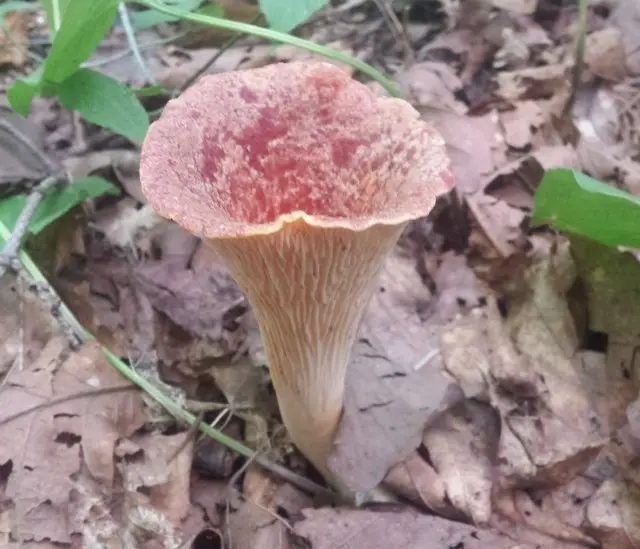Гомфус чешуйчатый (Turbinellus floccosus)
- Division: Basidiomycota (Basidiomycetes)
- Subdivision: Agaricomycotina (Agaricomycetes)
- Class: Agaricomycetes (Agaricomycetes)
- Subclass: Phallomycetidae (Velkovye)
- Order: Gomphales
- Family: Gomphaceae (Gomphaceae)
- Rod: Whirlwind
- Type: Turbinellus floccosus (Гомфус чешуйчатый)
:
- Gomphus floccosus;
- Chantharellus floccosus;
- Merulius floccosus;
- Turbinellus floccosus;
- Chanterelle floccosus;
- Neurophyllum floccosum;
- Neurophyllum floccosum;
- Turbinellus floccosus;
- Cantharellus canadensis;
- Chanterelle prince.

For its rather unusual appearance, Gomphus scaly (Motley chanterelle) regularly falls into various top 10 “The most beautiful mushrooms in the world”, “The most unusual mushrooms” and even “The most incredible mushrooms in the world”. Naturally, the constant mention in such charts makes many mushroom pickers want to find this mushroom. Unfortunately, you don’t need to go further than “find, see and photograph”: the mushroom is not recommended to be eaten due to the fact that it can cause digestive disorders. There is information (“Poisonous Mushrooms of Our Country” – Vishnevsky M.V.) that a toxin, tar-like norcaperic acid, was found in it, provoking the development of gastroenteritis. Meanwhile, in the markets in Mexico, according to information from the same book, Gomphus scaly is sold as a completely edible mushroom.
Description:
Ecology: Forms mycorrhiza with conifers, grows singly or in small groups, on the soil, in coniferous and mixed forests.
Season: summer – autumn (July – October).
Fruit body the shape is most similar to a vase. Rather fleshy, 6-14 cm high and 4-12 cm across.
Upper surface of the cap: Cup-shaped, funnel-shaped, sometimes quite deeply pressed, for which the mushroom is sometimes called the “mushroom-pipe” and “mushroom-jug”. Moist in young mushrooms, covered with appressed soft scales of approximately the same size. This hairiness gave the mushroom a few more names: hairy, scaly or woolly fox. But these names are not used too often, perhaps because the fungus itself is quite rare (although there are references that it occurs quite often in North America, the Far East and South Siberia). The color can vary from dark orange to reddish orange or brownish orange, with yellowish spots and zones. The edge is thin and wavy.
Lower surface: deep down, almost to the very base of the leg, covered with small longitudinal wrinkles and folds. The folds are often bifurcated and/or decussated. In young mushrooms, creamy, creamy-white in color, discolors with age, acquires a brownish tint when ripe.

Leg: 4-10 cm high and 2-3,5 cm wide. Cone-shaped, narrowed towards the base. The transition between the stem and the cap is almost indistinguishable. The color at the stem is like the underside of the cap, creamy, or with dull yellow hues.
Pulp: from white to whitish, according to some sources – orangey-yellowish. Fibrous. Does not change color when cut.
Smell: very weak mushroom.
Taste: sweet, sweet and sour.
spore powder: ocher yellow.
Microscopic characteristics: spores 11-17 * 5,5-8 microns, ellipsoid with a snot-like apical end, finely warty.
Edibility: as mentioned above, the mushroom is not recommended for eating.
Similar speciesare mentioned:
Gomphus bonarii is bright red in color with white hymenophore folds and with more pronounced either scales or growths on the upper part of the cap.
Gomphus Kauffman (Gomphus kauffmanii) is larger, scaly, more yellow.
: my attempts to find out what kind of animal this “norcaperic acid” is to no avail. Search engines give out this name only on a few sites of near-medical subjects, in sections about medicinal mushrooms, and in the specified book. Neither a normal Latin name nor a description has yet been found. However, I didn’t really want to.









